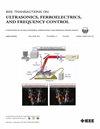Scale Interdigital Transducer-Based Microacoustic Resonators Into mmWave Applications
IF 3.7
2区 工程技术
Q1 ACOUSTICS
IEEE transactions on ultrasonics, ferroelectrics, and frequency control
Pub Date : 2025-03-24
DOI:10.1109/TUFFC.2025.3554004
引用次数: 0
Abstract
Different orders of Lamb wave mode resonators using interdigital transducers (IDTs) and LiNbO3 thin films are increasingly important due to their large electromechanical coupling (基于数字间换能器的微声谐振器在毫米波中的应用。
使用数字间换能器(idt)和LiNbO3薄膜的不同阶的Lamb波模式谐振器越来越重要,因为它们具有大的机电耦合(kt2)和高相速度,这对于毫米波小型化声学滤波器至关重要。在50个Ω系统中,实现适当的阻抗匹配需要大的静态电容。然而,这种电容可能与自感相互作用,导致目标频谱中的多个电磁(EM)自共振,这是将声波用于毫米波应用的主要瓶颈之一。这些谐振会降低谐振器的串联品质因子(Q),改变谐振器的电容特性,从而显著降低滤波和参考频率的性能,特别是在高阶兰姆波模式下。与sub-6 GHz系统不同,需要一种新的建模方法来分析5G/6G毫米波频谱中之前被忽视的EM-acoustic耦合。本研究提出了新的idt设计理念,以减少毫米波应用中的自感,探索idt内声波和电磁波之间的相互作用,并为各种场景引入新的等效电路模型。为了验证这些方法,在Y-128°切割的LiNbO3薄膜上制作了器件。仿真和实验结果均证明了该方法的准确性和有效性。这项工作能够在毫米波范围内有效地使用IDT,而不牺牲必要的静态电容,并基于所提出的多物理场等效电路模型解释了EM效应。
本文章由计算机程序翻译,如有差异,请以英文原文为准。
求助全文
约1分钟内获得全文
求助全文
来源期刊
CiteScore
7.70
自引率
16.70%
发文量
583
审稿时长
4.5 months
期刊介绍:
IEEE Transactions on Ultrasonics, Ferroelectrics and Frequency Control includes the theory, technology, materials, and applications relating to: (1) the generation, transmission, and detection of ultrasonic waves and related phenomena; (2) medical ultrasound, including hyperthermia, bioeffects, tissue characterization and imaging; (3) ferroelectric, piezoelectric, and piezomagnetic materials, including crystals, polycrystalline solids, films, polymers, and composites; (4) frequency control, timing and time distribution, including crystal oscillators and other means of classical frequency control, and atomic, molecular and laser frequency control standards. Areas of interest range from fundamental studies to the design and/or applications of devices and systems.

 求助内容:
求助内容: 应助结果提醒方式:
应助结果提醒方式:


